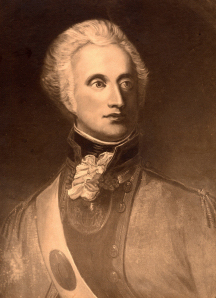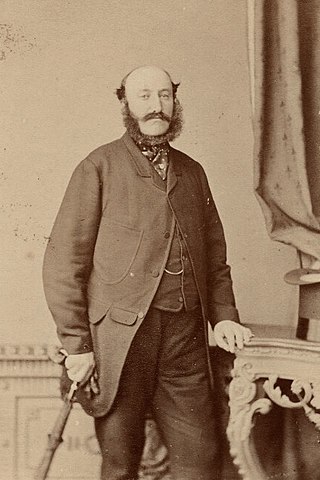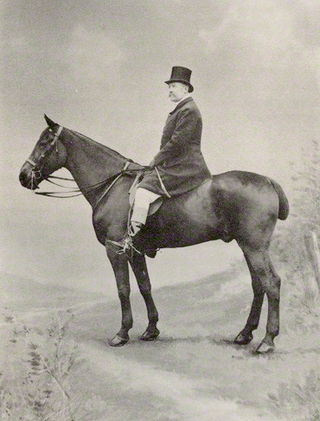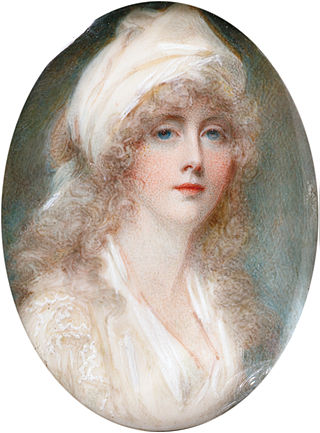
Henry Somerset, 1st Duke of Beaufort, KG, PC was an English politician who sat in the House of Commons at various times between 1654 and 1667, when he succeeded his father as 3rd Marquess of Worcester. He was styled Lord Herbert from 1644 until 3 April 1667. The Dukedom of Beaufort was bestowed upon him by King Charles II in 1682.
A queen dowager or dowager queen is a title or status generally held by the widow of a king. In the case of the widow of an emperor, the title of empress dowager is used. Its full meaning is clear from the two words from which it is composed: queen indicates someone who served as queen consort, while dowager indicates a woman who continues to hold the title from her deceased husband. A queen mother is a former queen consort, often a dowager queen, who is the mother of the reigning monarch.

Lord Charles Henry Somerset PC, born in Badminton, England, was a British soldier, politician and colonial administrator. He was governor of the Cape Colony, South Africa, from 1814 to 1826.

David Robert Somerset, 11th Duke of Beaufort GCC, known as David Somerset until 1984, was an English peer and major landowner.

Henry Hugh Arthur FitzRoy Somerset, 10th Duke of Beaufort, styled Marquess of Worcester until 1924, was a peer, landowner, society figure and a great authority in the fields of horse racing and fox-hunting. He held the office of Master of the Horse for over forty years (1936–1978), the longest to hold the position. He founded the Badminton Horse Trials and was deemed "the greatest fox-hunter of the twentieth century"; his long tenure as Master of the Beaufort Hunt led to his being universally nicknamed Master and his car bore the private numberplate MFH1. In 1980 he published the authoritative book Fox-Hunting.

Henry Charles Somerset, 6th Duke of Beaufort, KG, styled Marquess of Worcester until 1803, was a British politician.

Major Henry Somerset, 7th Duke of Beaufort, KG, styled Earl of Glamorgan until 1803 and Marquess of Worcester between 1803 and 1835, was a British peer, soldier, and politician.

Henry Charles FitzRoy Somerset, 8th Duke of Beaufort, KG, PC, styled Earl of Glamorgan until 1835 and Marquess of Worcester from 1835 to 1853, was a British peer, soldier, and Conservative politician. He served as Master of the Horse, Member of Parliament for East Gloucestershire, and Lord Lieutenant of Monmouthshire.

Captain Henry Adelbert Wellington FitzRoy Somerset, 9th Duke of Beaufort, styled the Earl of Glamorgan until 1853 and Marquess of Worcester between 1853 and 1899, was a British peer.
William Beauclerk, 8th Duke of St Albans was an English aristocrat.
Lord Henry Richard Charles Somerset, PC, DL, JP was a British Conservative politician and composer of popular music. He served as Comptroller of the Household under Benjamin Disraeli between 1874 and 1879.

Mary Somerset, Duchess of Beaufort also known by her other married name of Mary Seymour, Lady Beauchamp and her maiden name Mary Capell, was an English noblewoman, gardener and botanist. Among her introductions to British gardening are Pelargonium zonale, Ageratum species and Passiflora caerulea.
Since William the Conqueror claimed the English throne, succession has been determined by bequest, battle, primogeniture, and parliament.

Frances Evelyn "Fanny" Boscawen was an English literary hostess, correspondent and member of the Blue Stockings Society. She was born Frances Evelyn Glanville on 23 July 1719 at St Clere, Kemsing, Kent. In 1742 she married Admiral The Hon. Edward Boscawen (1711–1761). When his navy work took him away from home, his wife would send him passages from her journal, some of which were later published.

St Michael and All Angels is a Grade I listed church on the estate of the Duke of Beaufort in the village of Great Badminton, Gloucestershire, England. Attached to the Duke of Beaufort's residence, Badminton House, it is an active Anglican parish church in the diocese of Gloucester. Although within the grounds of the Badminton Estate, the church is owned, and its upkeep met, by the Badminton's Parochial Church Council, rather than the Ducal estate. There is a smaller church of the same name in the neighbouring hamlet of Little Badminton.

Anne Mee, née Foldsone (1765–1851) was a prolific English miniature painter of the late 18th and early 19th centuries.

Charlotte Sophia Somerset, Duchess of Beaufort, formerly Lady Charlotte Sophia Leveson-Gower, was the wife of Henry Somerset, 6th Duke of Beaufort.
Georgiana Somerset, Marchioness of Worcester, formerly Georgiana Frederica Fitzroy, was the first wife of Henry Somerset, 7th Duke of Beaufort, but died prior to his inheriting the dukedom.
The Scudamorefamily is an English noble family. The family settled in Herefordshire at two seats, Holme Lacy and Kentchurch Court, before lines moved to Devon, Somerset and Derbyshire. The family first gained prominence in the 15th and 16th centuries, before becoming ennobled as Viscount Scudamore and Baron Dromore in the 17th century, and were granted two baronetcies in 1620 and 1644. The family married into several noble dynasties including the Cecil, Beaufort, and Howard families, and became ancestors to the Earls of Chesterfield.
Sir Walter Rockcliffe Farquhar, 3rd Baronet JP DL was an English landowner of Scottish heritage.












